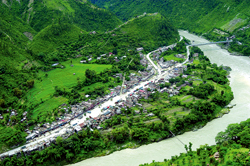 Much has been made of the emerging possibility of Nepal taking geopolitical advantage of its geographical position between India and China.
Much has been made of the emerging possibility of Nepal taking geopolitical advantage of its geographical position between India and China.
With China now India's second-largest trading partner, the opening of Nathu La in Sikkim, and the arrival of the railway in Lhasa, the matter of Nepal being a transit country has taken on a new sense of urgency. Deputy prime minister KP Oli's pronouncement on his return from China in September that the Chinese had actually committed to "study" the extension of the Tibet railway to Panchkhal or Trisuli have raised expectations in the public.
Not only are these expectations exaggerated, they may also be misplaced. It's still not clear how Nepal would actually benefit (other than from road tax) from Indian and Chinese trucks roaring back and forth across future highways linking Tibet with Bihar. What would be much more important is to seek niche export markets for Nepali goods and services in both India and China, allowing Nepali companies to take advantage of our location to facilitate trade between the two neighbours. Instead of focusing on transit, Nepal should be trying to see how we can hitch our wagons to the locomotives of the Chinese and Indian economies.
A book like Nepal as a Transit State: Emerging Possibilities by Nischal Nath Pandey is at least ten years ahead of its time. Being the scion of former foreign minister Ramesh Nath Pandey and the ex-chief of the Institute of Foreign Affairs (IFA) Pandey can be forgiven for being gung-ho about the idea. It was while Pandey Senior was foreign minister in the royal regime last year that King Gyanendra made the dramatic pronouncement that Birganj would be linked to Kodari by railway.
The book is a collection of four seminar papers exploring the idea of Nepal as a transit state between China and India. But just as the seminar was not clear about how Nepal would be transformed by being a transit state, the book is fuzzy as well. We can dream all we want, but at the end of the day do we have a plan on how to benefit?
Curiously, instead of looking at the issue outwards from the standpoint of Nepal, the presenters have tried to develop a patchwork theme from the perspectives of China and India. Since the economy of Tibet is at a high of 12 percent GDP growth per year, there is a market for Indian goods. Similarly as middle class affluence grows among the 220 million people of northern India, Chinese goods are already surging across.
True, Kathmandu has the advantage of regular bus services and flights to and from Lhasa. The Arniko Highway is operational and only 18km needs to be built to link Kathmandu via Syabrubesi to Kerung. The routes through Nepal are open in all seasons, while Nathu La in Sikkim has limited potential, as it is closed due to snow for four months in a year.
The authors (Tara Dahal, Dilli Prasad Bhattarai, Keshav Raj Jha, and Prakash A Raj) think the domestic economy can grow if new transit routes are opened up through Nepali territory, the service sector would prosper, and investments in intermediate goods will increase. They argue that by offering transit facilities, Nepal could benefit from both trade and taxes.
But one gets the feeling the authors are a bit futuristic, especially when they ambitiously propose seven transit routes between Tibet and India via Nepal when even the existing Kodari link is in such poor shape. They make too many assumptions and play down the constraints, such as how surface transport can compete with the ease of sea and air routes. They forget that Lhasa is 48 hours by train from Beijing, and that the eastern seaboard is a long way away from the plateau.
Nepal as a Transit State:
Emerging Possibilities.
Nischal Nath Pandey (Editor).
Institute of Foreign Affairs
Kathmandu. 2006


